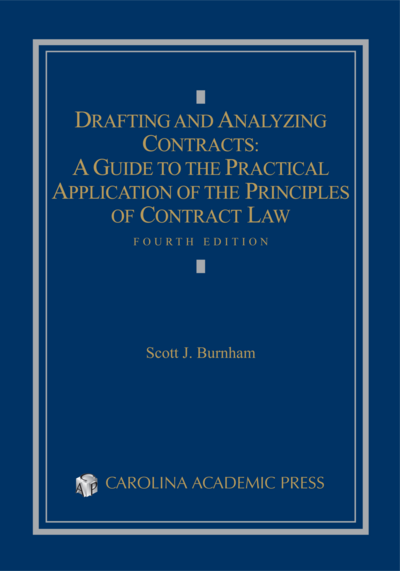Drafting and Analyzing Contracts
A Guide to the Practical Application of the Principles of Contract Law
Fourth Edition
2016
Teacher's Manual available
402 pp $63.00
ISBN 978-0-76984-897-6
eISBN 978-0-76989-669-4
Drafting and Analyzing Contracts (called Drafting Contracts in its first two editions) has three major parts: Part I is organized around the topics that are studied in the first year Contracts course. Part II teaches the skills of contract drafting. Part III teaches how to read a contract.
The purpose of this book is to apply the principles of contract law to the drafting of agreements. Each chapter discusses the substance of contracts as applied to drafting and suggests language that may be employed to accomplish the purpose. Drafting and Analyzing Contracts uses drafting to:
- exemplify the principles of contract law
- illustrate the principles in a planning context
- develop the skills of a lawyer.
Part I (How the Principles of Contract Law are Exemplified in Drafting) contains 14 chapters that illuminate the substantive law. For example: Chapter 7 demonstrates the problems that can arise from ambiguity and how to cure them; and Chapter 10 makes clear how drafters can use the concept of conditions to accomplish their goals. This Part is particularly useful to supplement the first-year Contracts class.
Part II (How the Principles of Drafting are Exemplified in Contracts) teaches techniques for contract drafting, including Drafting in Plain Language and Drafting with a Computer. This Part reinforces the substantive law and is particularly useful for upper-division classes that teach drafting.
Part III (How to Read and Analyze a Contract) shows how attorneys rely on forms and models where there is no opportunity for drafting. Therefore, attorneys must first read a contract before re-drafting it or explaining it to a client. Students who follow the "5 passes" process for reading contracts will develop and deepen their analytical skills.
A thorough Teacher's Manual (available only to professors) provides guidance on teaching drafting, commentary on all parts of the book, solutions to all the problems, additional problems, and a bibliography.
Editorial Reviews
"The book is well organized into twenty clearly defined chapters. Each chapter boils the relevant contract law into nicely terse "blackletter" law segments with no cases (a plus!) or irrelevant matter. This may serve the dual function of reminding students taking a contract drafting class about the applicable law for purposes of such a class, but also to refresh their memories again before taking the bar...The book also asks students to address various ethical concerns, which is a plus... In short: this book contains much good substantive information and features a wealth of different types of exercises. I highly recommend that you examine this book for your potential classroom or other use."
— Myanna Dellinger, ContractsProf Blog
Comp Copy If you are a professor teaching in this field you may request a complimentary copy.


